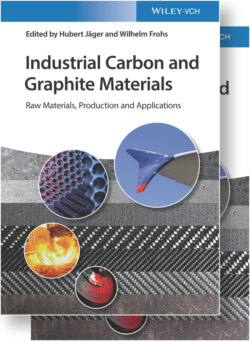Читать книгу Industrial Carbon and Graphite Materials - Группа авторов - Страница 267
6.1.1.1.4.2 Petroleum Pitch
ОглавлениеPetroleum pitch can be obtained from the lube oil process, from asphaltic residues from vacuum distillation, and from deasphalting units [34]. Improved petroleum pitch qualities can be obtained by treatment of decant oils, e.g. by dealkylation and dehydrogenation followed by condensation and polymerization reactions [35]. Condensation reactions can be enhanced by the addition of sulfur or Lewis acids [36, 37]. Today the main sources of petroleum pitch are decant oils from the catalytic cracker unit. The availability of commercial petroleum pitch is, however, limited to few producers.
The interest in petroleum binder pitch in the graphite industry is rather limited. The reason is the poor artifact properties resulting from its use, particularly due its low carbon yield. This low carbon yield is due to a lower degree in aromaticity compared to CTPs. Thus petroleum‐derived pitch is used for binder application only in blends with CTP. Petroleum pitch is a niche product with currently one producer only.
The by far biggest consumer for CTP is the aluminum industry for the production of anodes. Their demand for the production of 51 million t of primary aluminum needs about 6 million t of CTP (Figure 6.1.1.8). The carbon and graphite industry is a comparatively small consumer. In total the CTP demand is about 7 million t representing a coal‐tar demand of about 14 million t vs. an annual production of about 23 million t.
Figure 6.1.1.8 World usage of pitch. (Source: modified after Himadri Annual Report 2014 [38]).
With the closure of several coke ovens in Western Europe, the tar sources have been shifted eastward. Due to the growing Chinese blast furnace steel production, China has become the biggest tar producer (Figure 6.1.1.9). The worldwide production of tar has been increasing due to the high demand for coking coal in blast furnaces in China to an annual production of about 14 × 106 t. This adequately covers the tar demand for pitch production of about 7 × 106 t on a global basis. Local situations are different as pitch producer and pitch consumer may be located to a certain extent far away from the large tar sources. Due to high oil and fuel oil prices, coal tar competes in the energy sector and is more and more used as a fuel and as carbon feedstock.
Figure 6.1.1.9 Global coal‐tar production (CRU).
